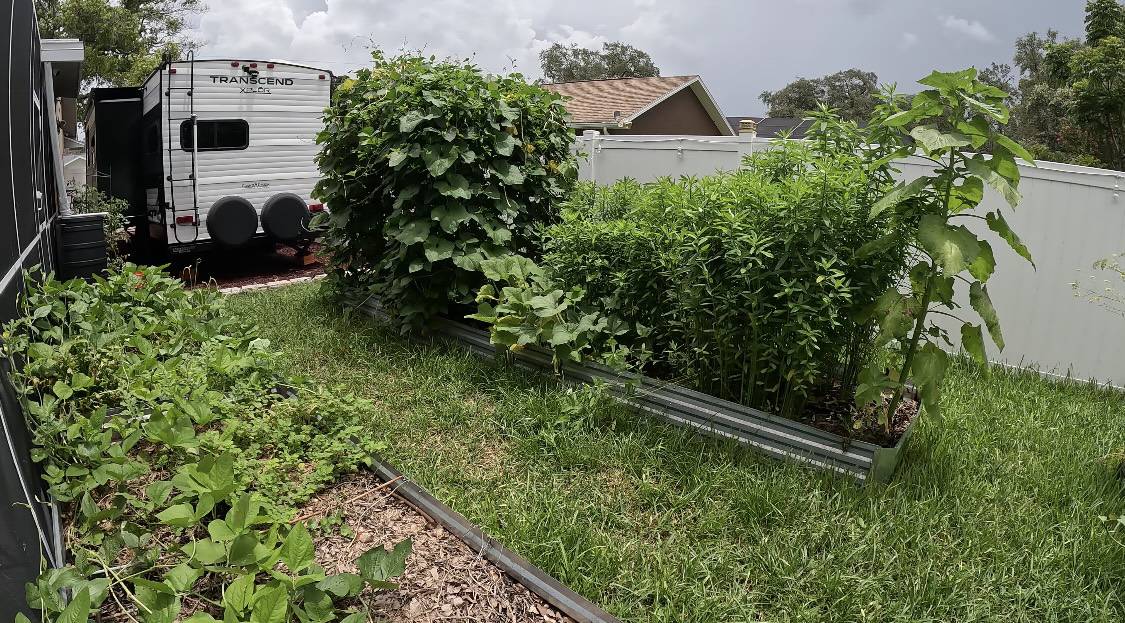Last Updated on April 10, 2025 by Homegrown Florida
Today we’re diving into the what to plant in April in Florida. As we embrace the warmth of spring, it’s the perfect time to get our hands dirty and start planting. As the cold season crops bid farewell, it’s time to embrace the heat-loving summer crops. Whether you’re in Central Florida like me (Zone 9B), further south, or even up to Zone 8, there’s plenty to do in the garden this month.
Table of Contents
Understanding April’s Climate
April marks our last month of relatively mild weather before the intense heat of summer sets in. Here in Central Florida, temperatures are reaching into the 80s, occasionally higher. South Florida gardeners might experience even warmer conditions, while those in Zone 8 enjoy pleasant mid to high 70s. Rainfall is minimal during this period, with our typical daily showers not starting until June or July. These conditions are ideal for many warm-weather crops but signal the end for most cool-weather varieties.
Leafy Greens: Embracing Tropical Varieties
While traditional cool-season leafy greens like lettuce, carrots, broccoli, and Brussels sprouts are out of the picture now, we can turn to heat-tolerant tropical greens. One standout is Sissoo spinach. This perennial closely resembles regular spinach in taste and texture, without the mucilaginous quality found in some other tropical greens. It’s my personal favorite and thrives throughout the year.

Other tropical greens to consider include:
- Red Malabar Spinach: A vining plant with succulent leaves.
- Longevity and Okinawa Spinach: Known for their health benefits and ornamental appeal.
- Cranberry Hibiscus: Adds a tangy citrus flavor and vibrant color to salads.
- Katuk: Often referred to as “sweet leaf,” it’s a nutritious addition that tastes like peas.
These greens not only withstand the heat but often thrive in it, providing a continuous harvest during the warmer months.
Fruiting Crops: Timing is Everything
For fruiting crops, timing your planting is crucial to ensure they mature before the peak of summer heat and pest activity. Here are some recommendations to plant in April in Florida:

- Tropical Squashes: Varieties like Seminole pumpkins, Tahitian melon squash, and Tromboncino are excellent choices. These belong to the Cucurbita moschata family, making them more resistant to pests like squash vine borers. They root along the ground, so even if one part of the plant is damaged, the rest can continue to thrive. Plant in April in Florida to establish them before the intense summer heat.
- Chayote: A perennial vine producing pear-shaped fruits. While traditionally challenging in areas with cooler winters, with some protection, they can be a rewarding addition. They can also be grown as an annual if you have a long growing season.
- Luffa: Grown not just for sponges but also edible when young. They can be started now and will flourish through the summer.
Hot Weather Staples to Plant in April in Florida
Preparing for the upcoming heat means focusing on crops that not only tolerate but thrive in high temperatures:

- Sweet Potatoes: Begin sprouting slips now, as it takes about 4 to 6 weeks to produce them. Plant in April in Florida ensures a robust crop before the cooler months.
- Ginger and Turmeric: These can be started from store-bought rhizomes. Look for pieces with visible nodes, plant them just below the soil surface, and expect sprouts by April. They rely on specific temperature cues to emerge, so patience is key.
- Roselle: Start seeds now to allow the plants to grow large before they begin flowering in response to shorter daylight hours in the fall. A larger plant means a more abundant harvest of calyces for teas and jams.
Other heat-loving crops to consider include:
- Peanuts: Require a long growing season and thrive in the heat.
- Cowpeas (Southern Peas): Also known as black eyed peas. Excellent for nitrogen fixation and can handle high temperatures.
- Okra: Loves the heat and produces prolifically.
- Jicama: A vine that produces edible tubers, best started now for a fall harvest.
- Lima Beans: Heat-tolerant so plant in April in Florida for a summer harvest.
If you’re looking for even more detailed guidance on growing veggies here in Florida—like when to start seeds, how to manage pests, and what varieties really thrive—don’t forget to check out my ebook! It’s got a chapter for every single vegetable and is packed with everything I’ve learned over the years gardening in Florida.
Embracing Fruit Season
April is a fantastic time to focus on fruiting plants. Many fruit trees and bushes can be planted now, including:

- Pineapples: Start from tops or pups. While they take about two years to produce fruit, they’re a rewarding addition.
- Papayas: Fast-growing and can produce fruit within a year. Homegrown papayas are often sweeter and more flavorful than store-bought ones.
- Bananas: Once established, they provide shade and fruit. Ensure they have ample space and nutrients.
- Avocados and Mangoes: Best suited for frost-free areas. Planting now allows them to establish before cooler temperatures.
Flowers: Adding Beauty and Benefiting the Garden
Incorporating flowers into your garden not only adds visual appeal but also attracts pollinators and beneficial insects. Consider planting:

- Zinnias: Thrive in the heat and come in various colors and forms.
- Sunflowers: Their cheerful blooms can brighten any garden space.
- Marigolds: Known for pest-repelling properties and vibrant hues.
- Nasturtiums: Edible flowers that add a peppery flavor to dishes and deter pests.
- Petunias and Chamomile: While petunias may not last all summer, they provide early color. Chamomile offers delicate blooms and can be used for teas.
Crops to Avoid Planting Now
It’s important to note that certain crops are best avoided during this time:
Tomatoes, Tomatillos, Peppers, Eggplants, Melons, Cucumbers: Starting these from seed now isn’t advisable. The plants may grow but often succumb to diseases or pests before producing a meaningful harvest. If you’re in the northern parts of Florida (Zone 8), you might still have a window for transplanting these, especially melons, which handle heat better. However, it’s essential to get them established as soon as possible.
Garden Maintenance Tips
As temperatures rise, maintaining your garden becomes crucial:
- Mulching: Apply mulch around plants to retain moisture, regulate soil temperature, and suppress weeds.
- Watering: Water deeply and consistently, preferably in the early morning or late afternoon to reduce evaporation.
- Fertilizing: Use a balanced fertilizer to provide essential nutrients. Be mindful of the specific needs of each plant type.
- Pest Management: Regularly inspect plants for signs of pests or diseases. Early detection and intervention are key to managing issues organically.
By focusing on heat-tolerant plants and maintaining proper garden care, you can enjoy a productive and beautiful garden throughout the warmer months in Florida. Happy gardening!
Need help planning your garden beyond this month? Check out What to Plant Each Season in Florida for a full breakdown of the best vegetables, herbs, and flowers to grow throughout the year. It’s your go-to guide for staying ahead of the seasons and getting the most out of your Florida garden.




